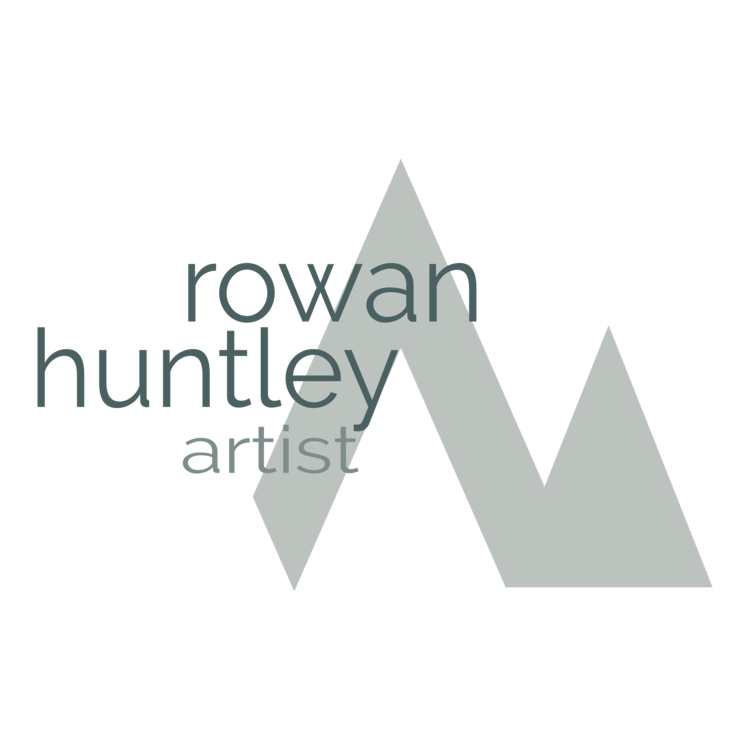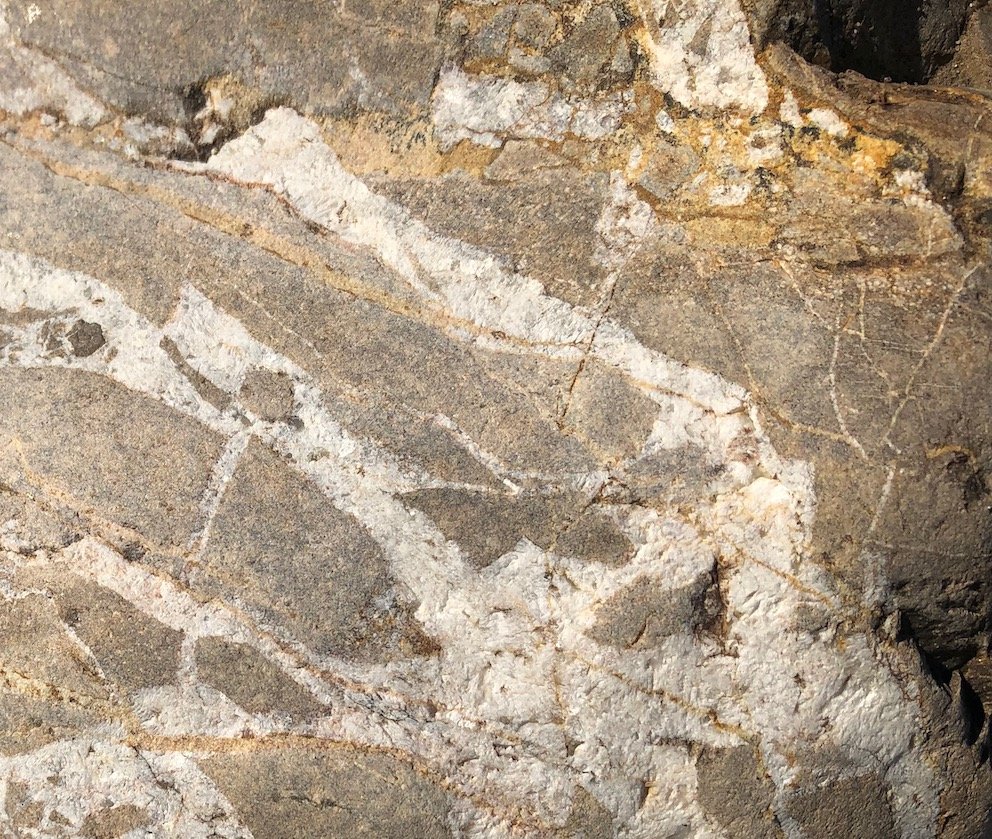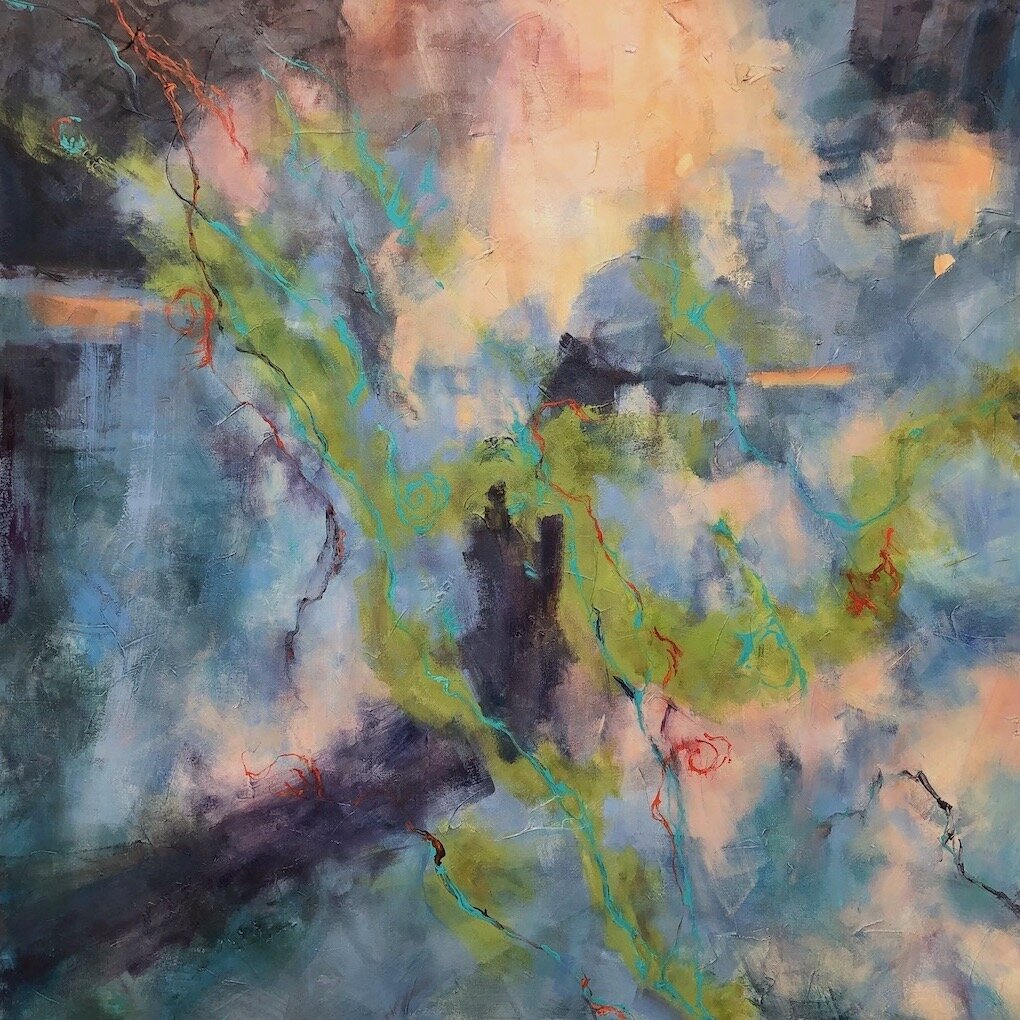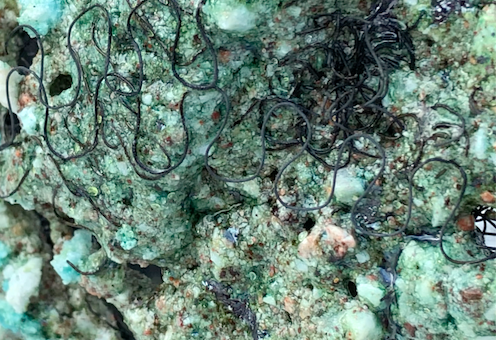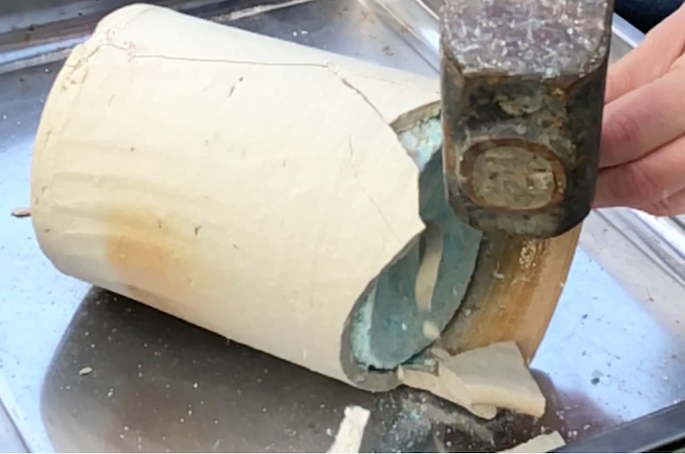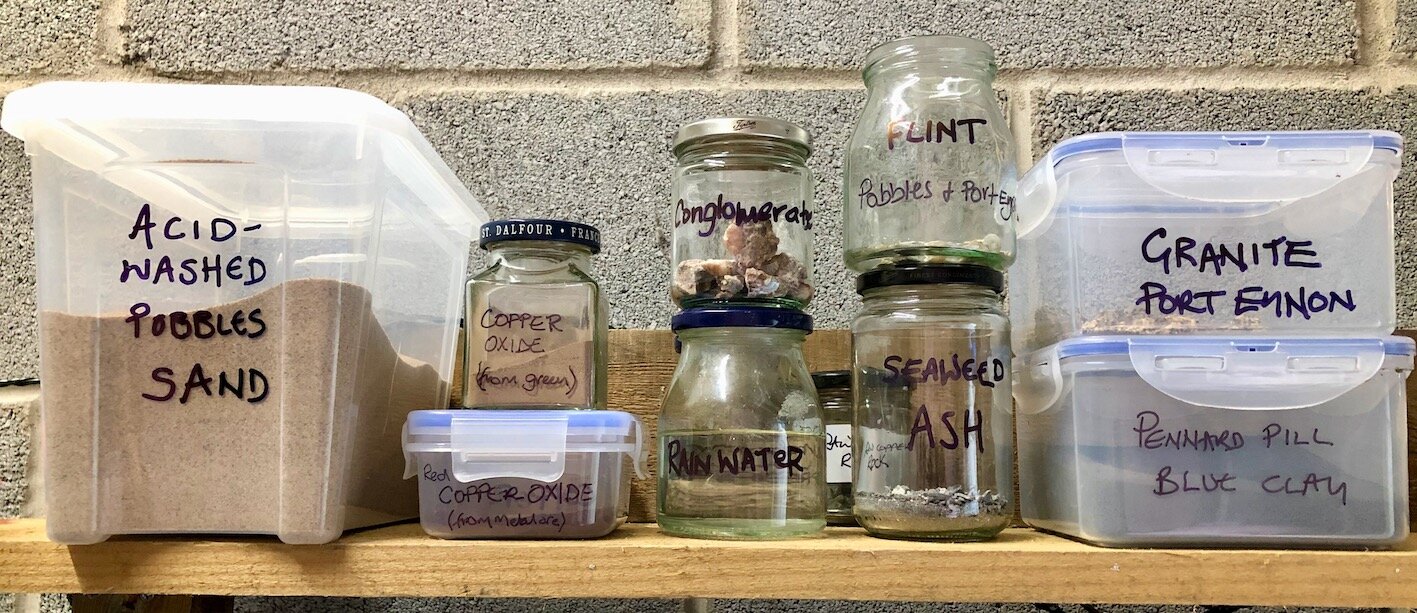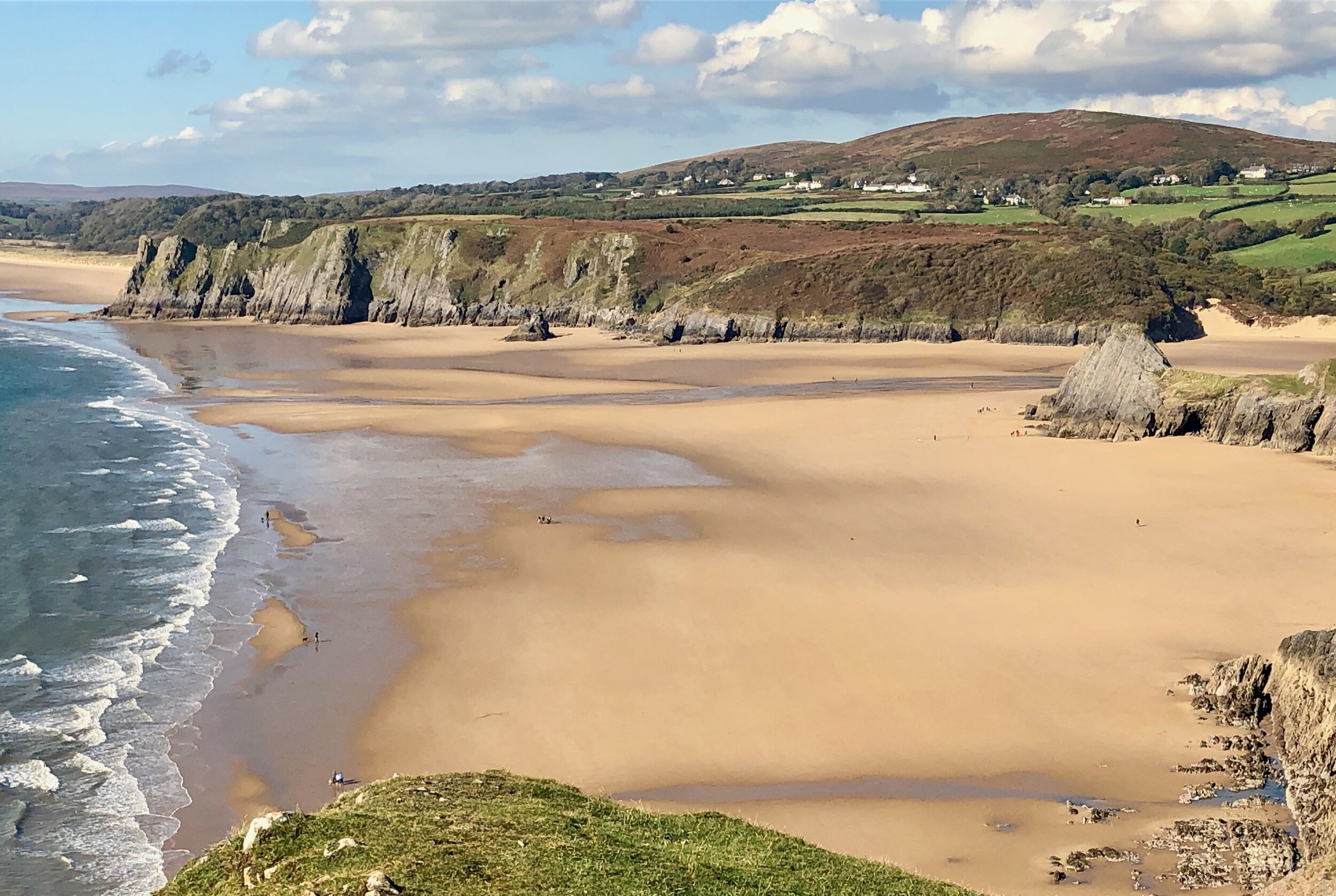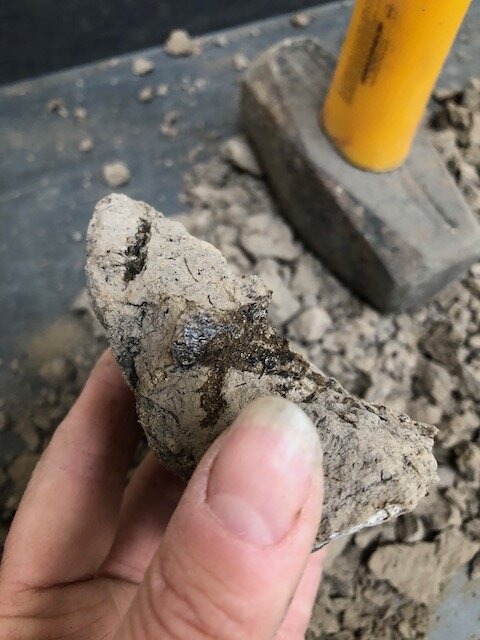‘Elemental’ 100cm X 100cm, acrylic on canvas
an open mind
It’s been a joy to spend some time outside drawing again after the seemingly endless rain of late.
Walking the cliffs I’ll sit a while here and there, write a little and absorb the colours, sounds and smell of the sea. Sometimes fog will dance around the headland while Choughs flit close by on the wind, enhancing a sense of mystery.
Scrambling down to the rocks below reveals a myriad of texture and pattern and it’s here all comes together in drawing.
vitrification
My experiments with vitrification continue to surprise and delight!
Sand is the foundation material of my trials. It is primarily quartz, which formed millions of years ago in molten rock. Over hundreds of millennia this has been ground, worn, transported and deposited in several cycles to produce the granular substance we see on our seashore today.
The process of vitrification, or producing a glass-like substance, occurs under great heat. Crystalline matter (quartz sand) is transformed into a non-crystalline, amorphous material. This is not a re-construction of quartz but is instead a new material with fascinating properties: glass. The process and chemistry of this transition epitomises the notion of re-creation in destruction and is an a key area of exploration in my examination of Jo’s work.
like-minded people
It’s always interesting to meet like-minded people. Today I had the huge pleasure of spending several hours with the lovely conservationist Madi, of Madison Wildlife, who has invited me to participate in an episode of Gower Watch. This small series she’s making is dedicated to the Gower Peninsula and follows her adventures around Gower where she unearths stories and documents notable species and interesting facts about Gower as a whole.
Madi said: “I've always been an advocate for communicating science in ways that fits all strands of learning, and having seen your work in collaboration with BAS, I'd absolutely love to hear and see more, and interview you on Gower Watch about your work.” How could I refuse?!
So, on what has been a beautiful autumn day, Madi visited my workshop and interviewed me in my studio filmed by professional cameraman Vinnie. It’s been a hugely enjoyable experience and I’m now looking forward to seeing the end result in due course. In the meantime find out more about Madi and her work on https://www.madisonwildlife.com
Thank you for your interest in my work Madi!
Madison Bowden-Parry
from the workshop
I find making exploratory studies to be of great value when working with new materials and / or processes. Looking at the behaviour of component parts, particularly when combining in new ways or under different conditions, often leads to an unplanned or surprising outcome. Unexpected results are worth recording, they provide useful insight and thus the opportunity to either utilise or avoid the element of chance in future creations.
Understanding how things react and interact can open up all kinds of exciting possibilities and new directions. I love the freedom of this way of working!
a feeling of Carrick shore
I recently enjoyed some quiet holiday time on the beautiful Solway coast of Galloway in southern Scotland.
How familiar its grey rock appeared at first glance but how very different the geological history within! Unlike the grey sedimentary limestone of Gower which was formed in shallow tropical seas, this grey sedimentary rock was formed on the deep ocean floor (near the continental shelf) as a result of sub-marine avalanches of mud, silt and sand.
Called Greywacke (pronounced grey wackey) this is a hard Sandstone that contains clay. In this instance it’s surface is etched with angular, criss-crossed pressure lines, closely resembling lacerations which could easily have been thrust upon it by some sharp implement.
For me this conjures up imagery of being under attack, yet emerging scarred but not defeated from tremendous turmoil. A metaphor, perhaps, for the resilience now required by all, in the face of the continuing climate crisis.
timelines
Timelines, time, lines.
Lines that allude to a time between, a time before, a time to come.
Lines are ever present,
and tellers of time.
clepsydra
The Clepsydra is one of the earliest known forms of telling time. This ancient water clock utilises the managed flow of water either into, or out of, a particular vessel in order to measure the passing of time.
My take on the Clepsydra is a metaphorical response in which time is embodied in numerous ways. Not only through the creation of the vessel itself but also in the materials and processes used, such as clay, borax, quartz, metals and kiln firing. All of these relate to my research in collaboration with Jo and reflect my reaction to issues around rising seas and glacial ice melt.
This creation also answers the question ‘what will this become?’ posed in my previous blog. A splendid, valuable, integral part of my Clepsydra that’s what! Of course.
success in failing
No one likes to fail and it’s not easy to embrace failure. But I’m finding that by changing my perception of what failure is, I have begun to do just that. Where once I’d see catastrophe, now I find potential and that has been a liberating experience.
Of course there are many forms of failure and I don’t profess that a change of view can rectify all, in the broader sense.
But in my work, where in particular I’m looking at both the physical make up of geology and the processes by which it is made, I have seen great benefit in working with what once I would have discarded.
The universe and earth itself are in continuous flux and have been since the beginning of time. Melting, solidification, grinding, folding, upheaving, bursting forth and so on, occur in an endless cycle of re-working. This underpins my philosophical view that all is interconnected and supports the notion that nothing is ever lost, it only changes form.
In destruction, therefore, there is creation. Taking this as my lead and opening my mind to relinquishing control, I have found space for re-evaluation through creative practice. This acceptance of chance and chaos over intention brings excitement and reward beyond the expected.
Failure is also a rich source of education. Learning from what went wrong, and finding ways to avoid repetition of perceived mistakes, provides both new insight and the encouragement to keep going!
Additionally, we live in a world where the throwaway society of modern times has done, and continues to do, untold damage to the biosphere on which we depend for survival. So, from an ethical stance, and following the lead of creation itself, reusing and recycling precious materials wherever possible is an absolute necessity. Rebooting our selves to see what something can become, instead of only what it was meant to be, can work in all walks of life. It contributes enormously towards strengthening a circular economy in which we should all play our part and, without doubt, uphold as a priority.
What will this become?
transmutation
Elements and minerals have different melting points and temperatures at which they become solid, so combining them is tricky. But weaknesses and stress fractures induced by unusual pairings can, in their incompatibility, produce intriguing results.
Undertaking explorations using metals, silicas and salts is originating some surprising transmutations. Disintegration from one form and subsequent re-formation into another is thus proving to be decidedly thought-provoking. Utilising chance initiates exciting and unpredictable outcomes, which definitely encourages my desire to embrace further possibility through continuing experimentation.
turmoil
Using paint, colour and sound to examine vulnerability, friction, destruction and re-formation in response to the undermining of our cryosphere.
turmoil - acrylic on canvas, 100cm X 100cm
the transformational power of heat
Some beautiful results from exploring what happens to certain geological materials when exposed to intense heat. These experiments used various combinations of solid material with differing temperatures. Between them they produced melting, explosion and fusion as well as vitrification, transforming the original materials into entirely new substances. This has great relevance to Jo’s work and huge potential for use in the creation of artwork relating to her scientific Data.
fresh air, sunshine and curiosity
Crisp, calm mornings are beautiful, they provide a perfect opportunity to get outside and up close with my local coastal geology. I return here again and again, there is always something new to discover and space to ponder the vast timescales on display all around.
In this picture I’m once more drawing amongst a raised Patella Beach, next to a wave-cut platform. Both of these date from the Eemian period 120,000 years ago and sit some 5m above the current sea level.
the excitement of not knowing
When bringing together different matter under intense heat, I inevitably leave much to chance. I am excited by the unpredictable, the results of chemical reactions and physical change which are beyond my control. Revealing what has occurred is always thrilling, a journey of discovery, wonder and learning!
the materials shelf
An ingredients cache is growing with the preparation of my found materials. Along with processing collected seaweed and wild clay from nearby I’m crushing various rocks, roasting metal ore and acid-washing beach sand.
Seeing how these fire in differing combinations at various temperatures is a time-intensive process. But it’s hugely exciting to see what will occur as I have no real idea of what may, or may not, happen.
Trial tiles to test recipes, drying out before firing.
This is a promising first result from the kiln!
beach combing
Beach-combing is so absorbing I can lose hours just wandering, sitting, looking and hopefully finding. Blessed with the second biggest tidal range in the world on my doorstep, there is much to explore when the tide is out. The Limestone cliffs yield calcium rich pebbles with calcite veins and crystals. A conglomerate ridge generates quartz rich pebbles entwined with Jasper.
Infrequently there is even some flint to be found. This, along with cobbles of granite not native to Gower but to Scotland, is most likely to have arrived as a result of glacial transportation in a past ice age.
Dry Seaweed from the high tide line is a rich find too. With a bit of (careful) preparation it provides Soda ash, a valuable ingredient for use in clay bodies and in glaze.
I admire the adventurous work of ceramic artists Lotte Glob, Miranda Forrest and Aneta Regel Deleu, who also work with the natural elements around them including rock and organics. Their pieces are imbued with a deep connection to the landscape in which they live and work, with intriguing and striking results.
beyond the aesthetic
Professional photographer Henry Iddon is passionate about both landscape and the art of photography. His incredible work reflects a deep sense of place which reaches far beyond aesthetic beauty. Telling of that which is no longer visible, of happenings and times past engrained and indelible, Henry’s work transcends the purely visual to stir something deep within.
I first met Henry about sixteen years ago at Kendal Mountain Film Festival. I was exhibiting paintings and he was official festival photographer. A love for the environment has endured for us both in the development of our work since, and I have grown to value, like Henry, the significance of encounter over recognition. Art’s importance lies in being effective/affective beyond the cultural object that it is.
Watch Henry at work, talking to the BBC Adventure Show:
the sense of touch
Using locally found materials allows me to link not only to the physical landscape but to the latent energies embedded within it. Such connections transcend the actual, inviting exploration of the space between that which appears in existence now (the visible), and that which does not (the invisible).
And so, being mindful to collect things from any environment with respect (and permission, if needed), I gather small amounts of pebble, rock, organics, sand and clay. Combining these with manufactured clays, minerals and compounds identified while researching Jo’s work, gives me wide and exciting scope for experimentation in their blending.
Material preparation such as crushing, sieving, dissolving etc. engenders intimate contact between inanimate matter and sentient human. Much can be conveyed through the sense of touch, so I greatly enjoy this tactile interaction. It lets me build greater understanding and closeness, not just with the physical material but with its very being; the chemistry, geology, biology and history of its existence.
Subsequently, enabling change to occur within such matter by exposure to great heat or intense cold allows those materials to be, and to become, what they will. As a result, rather than fostering recognisable outcomes and technical precision in my making, for the moment I’m concerned primarily with the orchestration of happenings. Or, as I prefer to call it, permitting serendipitous alchemy!
Preparation of clay takes time……. but gives time too:
a shiny new addition to the studio this month!
It may be tiny but this kiln is packed with potential and I am excited to see what it will do. My approach is not that of ceramicist but rather of artist who happens to use extremes of temperature in order to explore and create.
Investigating the physical transformation of materials using kiln, freezer and blow torch places me in direct contact with substance, history, science and great creative possibilities. It enables me to echo, metaphorically, the physical essence of Jo’s scientific research and to examine, in a contemporary way, its connections with both industrial south Wales and the ancient geology of Gower. I reflect evolutionary process and effect chemical change to bring tangibility to the invisible and tensions therein. By merging creativity, geology and chemistry and warmly embracing the occurrence of chance, I give rise to random outcomes which mirror those within the natural world.
'Making Isotopes' - acrylic on canvas
A figurative visualisation, reflecting my own memories of the Antarctic landscape combined with elements pivotal to Jo’s field expeditions and geochemical research.
